For hundreds of years, this process was kept secret by tea makers in China, and even getting a glimpse into the intricate inner workings was virtually impossible for outsiders.
Therefor the art of making oolong tea is little known outside China.
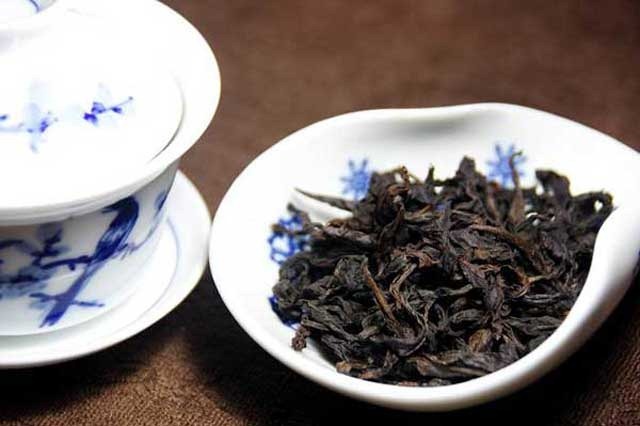
Hard Work Behind a Cup of Oolong Tea
Nowadays, even though most of the steps are public knowledge, aspiring imitators still find it hard to master the all of the skills needed to make truly great oolong tea.
Oolong tea can be machine or handmade. Premium grade oolong teas, such as the high grade Wuyi Rock tea and Anxi Tieguanyin, are always handmade.
Generally speaking, there are 7 major steps in processing Wu Yi oolong tea.
1.Harvesting
Cai Qing-Picking Tea Leaves
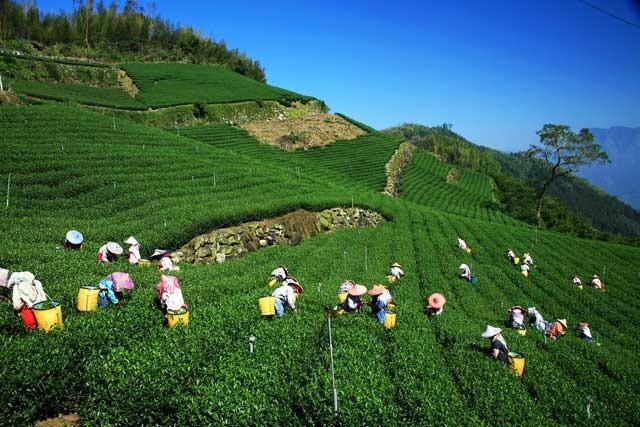
Cai Qing-Picking Tea Leaves
Oolong tea leaves are picked 3 to 4 times a year in spring, summer (once or twice) and autumn, which depending on the local climate conditions.
Autumn tea is also known as winter tea.
Oolong tea is made from more mature leaves consisting of one bud with 3 or 4 leaves.
They are picked when buds at the top of bushes mature to half the size of a fully grown leaf.
Quality varies with the season. Spring and autumn tea are higher quality than summer tea. Leaves picked during early spring are generally considered to have the highest quality. Tender leaves picked earlier in the season may be used to make higher grade tea.
The most exotic oolong tea - Champagne Oolong tea - uses younger leaves consisting of one-bud-and-two-leaf. The harvesting process is very much alike to green and white tea.
A popular picking technique is to face the hands upwards, hold the stem between the index and middle fingers, then break the stem gently using the thumb.
Only a properly trained tea picker knows how to gather the leaves in a way that maximizes their potential.
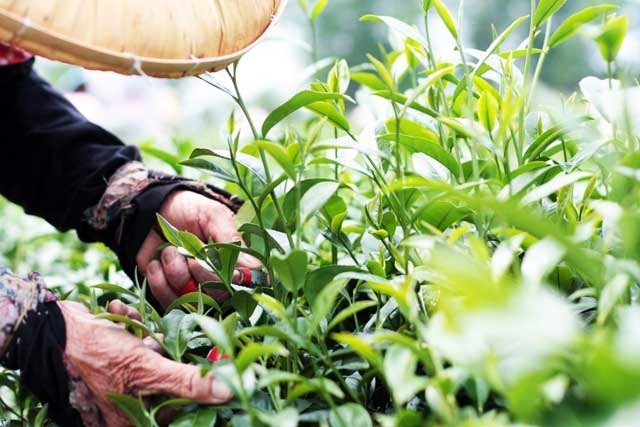
Cai Qing-Picking Tea Leaves
2.Withering
Wei Diao-Soften the Tea Leaves
After picked, the fresh oolong tea leaves are immediately transferred onto large wooden plates to be dried. Most leaves are dried both indoors and outdoors to balance the effects of heating and cooling.
This is important: the level of moisture determines how quickly tea polyphenols oxidize.
The leaves may alternate between indoor and outdoor, as too much sun can cause over-heating.

Wei Diao-Soften the Tea Leaves
As moisture vaporizes, fresh leaves soften and lose their natural springiness and luster.
But this is not a cause for concern. In the later stage (bruising), the leaves will regain their elasticity.
The general principle is to go "from thin to thick".
Initially the leaves are spread out thinly on a bamboo mat to prevent too much heat from accumulating inside the leaves.
In the later stage, the leaves are spread out more thickly.
The process also involves stirring, which distributes moisture evenly across the leaves and speeds up the oxidation process.
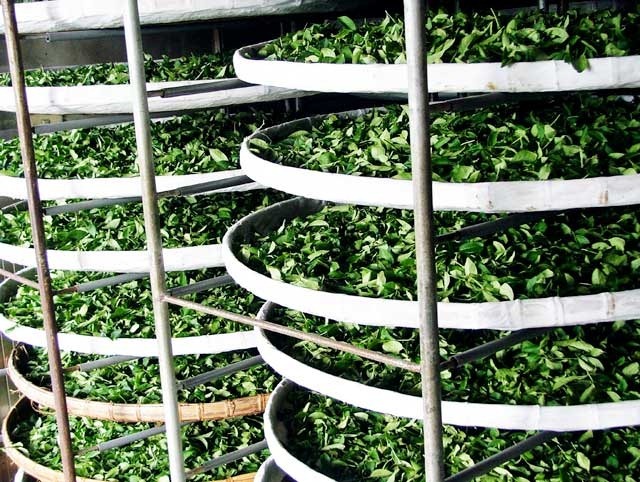
Wei Diao-Soften the Tea Leaves
3.Bruising
Zhuoqing or Yaoqing-Remove Moisture from the Tea Leaves
This is the most important step of the process. Bruising determines, to a very large extent, the quality and taste of oolong tea. A variety of techniques are used to bruise the leaves, including shaking and tumbling. Bruising is usually repeated many times to achieve an ideal level of oxidation.
For the Wuyi Rock tea, it can take up to 10 hours.
It should be seen as a continuation of withering.
The general principle is heavy bruising goes with light withering, and light bruising with heavy withering.
The bruising process removes moisture and grassiness.
During withering, leaves lose their suppleness. Amazingly, they are able to regain their elasticity towards the end of bruising.
Tea-makers shake withered leaves in bamboo baskets and hand press them. Someone use a bamboo tube to implement this process.
The friction bruises edges, exposes tea juices to air and speeds up oxidation.
The leaves are then spread out to slow down oxidation and other chemical changes.
This shaking-resting process is then repeated several times.
The length and intensity are adjusted to allow for variation in wind speed, light intensity, temperature and humidity on that particular day.
Initial bruising is light, then becomes progressively heavier.
In the later stage, the heavily bruised leaves experience a resurrection. Moisture travels from stems to leaves, causing them to regain their suppleness.
The process ends when leaf edges start to redden and aroma substances form.
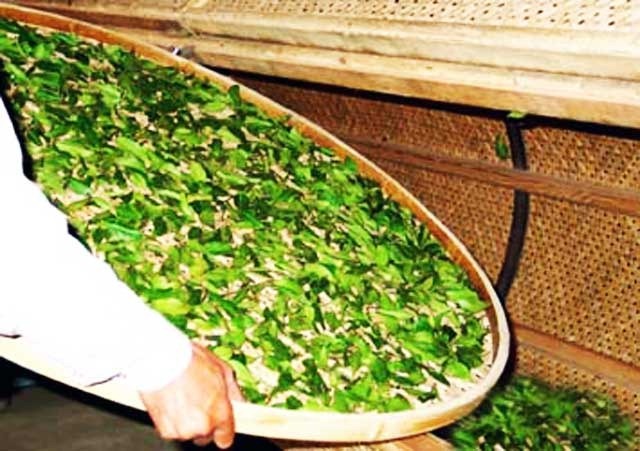
Zhuoqing or Yaoqing-Remove Moisture from the Tea Leaves
4.Fixation
Sha Qing-Kill Green
At the precise time when aroma substances have started to form and the tea leaves start to take on a red color, bruised leaves are pan-fried at high heat to kill the enzymes and stop the oxidation process.
This process is called fixation or Kill Green(Kill-green is a literal translation of the Chinese phrase for “stopping the oxidation.”) and lasts only a very short time.
The main purpose is to kill enzymes and stop oxidation. If it lasts too long, the leaves will lose too much moisture.
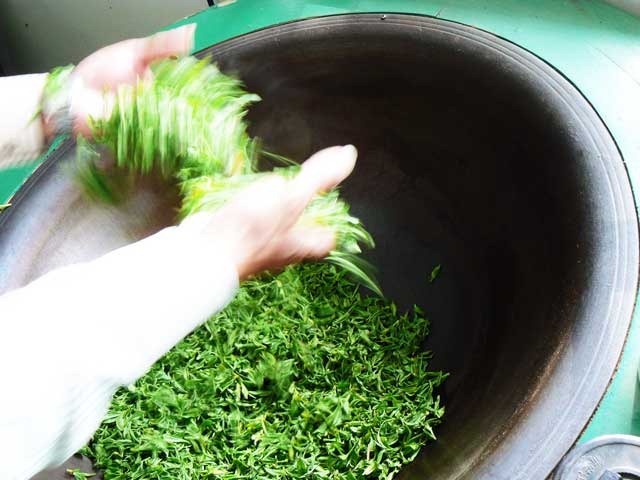
Sha Qing-Kill Green
5.Rolling and Shaping
Rounian or ZhuoXing-Shaping the Tea Leaves
During this step, oolong tea leaves are rolled and rubbed into the right shape.
Depending on the varieties, oolong tea can be either long and curly (Wuyi Rock tea), semi-rounded (Taiwan Dong Ding tea) or fully-rounded (Anxi Tieguanyin tea).
After the tea has been rolled, it is heated in some way, then rolled again.
This process should be repeated several times.

Rounian or ZhuoXing-Shaping
6.Baking
Hong Pei-Drying the Tea Leaves
If bruising “releases” the taste of oolong tea leaves, the second round of drying strengthens what has been released. Both high and low heat are used to completely remove moisture from the leaves and finalize their chemical profiles.
There are two parts to this process.
Mao Hong-General Baking
In the initial fast-baking process, high heat is applied for a short period of time. It removes moisture, stabilizes chemical profile and freezes external shape.
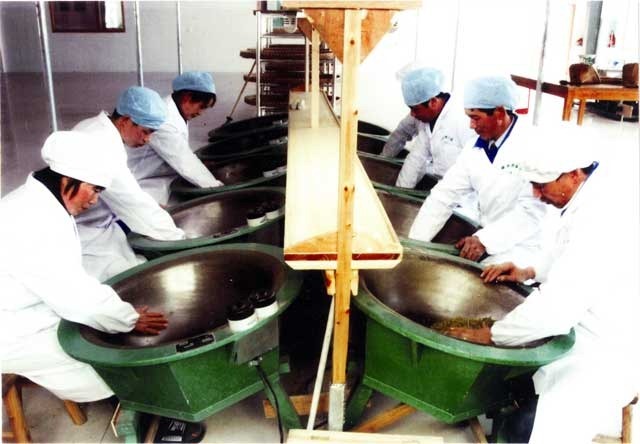
Hong Pei-Drying the Tea Leaves
Zhu Hong-Drying Tea Leaves in Bamboo Basket
Low heat is applied for an extended period of time. For Wuyi Rock tea, it can last up to 7 hours.
For some types of aged oolong tea, this step will be repeated on a yearly basis.
This is an important stage. The tea-maker decides how much "fire" goes into the tea.
The additional slow-baking improves the color and aroma of the tea liquor.
Wonder why oolong tea lasts for many more infusions than green tea? Slow baking makes oolong tea lasts longer.
The type of fuels used can impact tea quality. Charcoal is the best, followed by wood, electricity, gas, oil and coal.

Zhu Hong-Drying Tea Leaves in Bamboo Basket
7.Sorting, Cooling and Packaging
Tea leaves are sorted to remove sub standard leaves and twigs before they are transferred for packaging. This step is almost always done by hand, and skilled inspectors pick out inferior leaves.
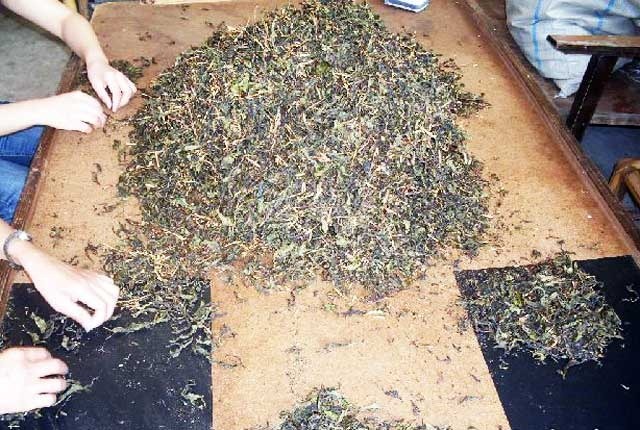
Sorting, Cooling and Packaging
Some of the tea leaves may need to be re-heated later, then cooled and packaged.
Some teas are made "on the spot" in the mountain. These teas are then carried down the mountain for storage in tea-houses.


I and also my buddies were actually reading the excellent advice found on your website and so instantly I had a terrible feeling I had not expressed respect to you for them. These guys were as a result excited to learn them and have now pretty much been loving those things. Many thanks for truly being very helpful and also for picking this form of quality topics millions of individuals are really desperate to discover. My honest apologies for not saying thanks to you earlier.
Nice read, I just passed this onto a colleague who was doing some research on that. And he actually bought me lunch as I found it for him smile Thus let me rephrase that: Thank you for lunch!
you're truly a just right webmaster. The website loading pace is incredible. It sort of feels that you are doing any distinctive trick. In addition, The contents are masterwork. you have performed a magnificent process in this subject!
Thank you a lot for sharing this with all people you actually know what you're talking approximately! Bookmarked. Kindly additionally seek advice from my web site =). We could have a hyperlink alternate contract between us!
Very great post. I just stumbled upon your blog and wished to mention that I have truly loved browsing your weblog posts. After all I’ll be subscribing on your rss feed and I hope you write once more soon!
Fascinating blog! Is your theme custom made or did you download it from somewhere? A theme like yours with a few simple tweeks would really make my blog shine. Please let me know where you got your design. Cheers
We are a group of volunteers and starting a new scheme in our community. Your site offered us with valuable info to work on. You have done a formidable job and our whole community will be thankful to you.
Hey There. I found your blog using msn. This is a really well written article. I will be sure to bookmark it and come back to read more of your useful info. Thanks for the post. I’ll certainly comeback.
Wonderful items from you, man. I have consider your stuff prior to and you are simply too excellent. I really like what you've got here, really like what you're stating and the way by which you assert it. You're making it entertaining and you continue to take care of to stay it smart. I cant wait to learn much more from you. That is really a terrific web site.
Thanks for another informative web site. Where else could I get that type of info written in such a perfect way? I've a project that I am just now working on, and I've been on the look out for such information.